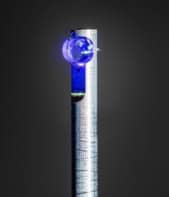
A new type of maser made from periodically driven xenon atoms can detect low frequency magnetic fields far better than any previous magnetometer, according to scientists in China and Germany. The researchers believe their device is ready for use in a proposed gravitational wave search and might in future be used to find hypothetical dark matter particles.
Masers are the microwave-wavelength equivalent of lasers and their extreme frequency stability allows them to make invaluable contributions to atomic clocks, radio telescopes and several other areas of physics. In a traditional maser – as in a traditional laser – the masing action occurs between two energy levels in an atomic or molecular gain medium confined in a cavity. As electromagnetic radiation bounces back and forth in the cavity, photons whose frequency is resonant with the energy difference between the two levels are repeatedly emitted and absorbed by the atoms. Eventually, a “population inversion” with more atoms in the upper level is achieved, and stimulated emission from these atoms produces a highly monochromatic beam of microwave radiation.
Floquet sidebands
With their new maser, Xinhua Peng and colleagues at the University of Science and Technology of China in Hefei, in collaboration with Dmitry Budker of Johannes Gutenberg University of Mainz in Germany, took a more subtle approach. They replaced the normal, static gain medium with a gas of xenon-129 atoms in a vapour cell. When placed in a magnetic field, atoms with nuclear spins aligned anti-parallel to the field become slightly higher in energy than atoms with parallel nuclear spins, and masing between the two energy levels is possible. A periodic perturbation applied to this field creates a periodic perturbation in the energy shift. This manifests as a series of so-called Floquet sidebands either side of the central masing frequency.
“If we see sidebands, we can see from the frequency of the sidebands the frequency of the magnetic field and, from the amplitude of the sidebands, the amplitude of the magnetic field,” explains Min Jiang, who is first author on a paper in Science Advances describing the work.
The researchers tested their Floquet maser at sensing perturbations when driven at various frequencies. They showed how the amplitude of the first-order sidebands grew as the driving frequency decreased, suggesting the magnetometer’s sensitivity was increasing. For driving frequencies below 1 Hz, it was not possible to make simple measurements like this as the maser entered a different regime showing a very large number of sidebands. The researchers therefore analysed the frequency spectrum of all the sidebands. Their measurements suggest that the magnetometer was most sensitive to extremely low frequency perturbations – the opposite behaviour to that seen in other state-of-the-art magnetometers such as superconducting quantum interference devices (SQUIDs) and spin exchange relaxation free (SERF) atomic magnetometers, which are more accurate at measuring higher frequency perturbations.
“Substantially better” performance
“We measured, for example, 1 mHz and then 10 mHz and then we fit our data,” says Jiang. Between 1–100 mHz, the researchers say, their device performed “substantially better” than any other magnetometer, with a sensitivity of 700 fT/Hz.
The current limitations of the device are not fundamental so the researchers believe that it should be possible to achieve even better sensitivity at even lower frequencies. “It’s mainly limited by the instability of our maser, which mainly comes from the laser that we use to optically pump the system,” says Jiang, “at low frequencies that noise goes up”.

Atomic magnetometer is most sensitive yet
With a more stable setup, it may be possible to reach a sensitivity of about 7 fT/Hz at 1 mHz. Even in its current form, the detector could help to monitor the alignment of the mirrors in eLISA (Evolved Laser Interferometric Space Antenna), which is a proposed space-based gravitational-wave observatory. A more advanced maser could prove invaluable in the hunt for ultralight dark matter particles, some of which are predicted to create low frequency magnetic fields detectable on Earth: “I think this opens a new window that nobody has reached before in dark matter searches,” says Peng.
Mike Romalis of Princeton University in New Jersey, one of the inventors of the SERF magnetometer, is sceptical, however. “I am sure that their conclusion that sensitivity improves at lower frequency is wrong,” he says. “They measured the frequency response only down to 1 Hz but then extrapolate down to millihertz and arrive at an un-physical conclusion. Sensitivity of any detector cannot improve indefinitely at lower frequency.”



